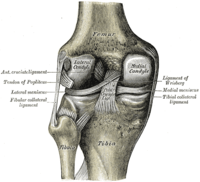
Photo from wikipedia
Fibular nerve neuropathy is the most common mononeuropathy at the lower limbs, characterized by deficit in dorsiflection of foot and toe (“foot drop”), sometimes associated with sensory impairment at superficial… Click to show full abstract
Fibular nerve neuropathy is the most common mononeuropathy at the lower limbs, characterized by deficit in dorsiflection of foot and toe (“foot drop”), sometimes associated with sensory impairment at superficial fibular nerve territory (lower lateral calf and dorsum of the foot). The most common cause of fibular neuropathy is external compression of the nerve at the fibular head (due to surgical complications, positional habits, tumors). Other causes are traumatic injuries, metabolic or vascular diseases, or excessive and rapid weight loss [1]. During the COVID-19 pandemic, most people were forced at home, often in smart working or in distance learning sitting for long time at the computer. In our study, we evaluate the frequency of fibular nerve palsy due to incorrect positional habits during the COVID-19 pandemic. We considered all the needle electromyography (EMG), nerve conduction studies (NCS) and nerve ultrasound (Mylab Seven Esaote Genova Italy) performed from April 2020 to March 2021 in the EMG Lab CEMES Data Medica in Padova (Italy). All the neurophysiologic and nerve ultrasound evaluations have been performed by the same neurophysiologist. Exclusion criteria were a recent history of traumatic injury or surgery of the leg, a recent hospitalization in Intensive Care Unit or long bedridden period, and a personal or familiar history of Hereditary Neuropathy with liability to Pressure Palsies. As control group, we considered all the patients referred to the same Neurophysiology Centre in the period from January 2013 to December 2019, considering the same exclusion criteria. We evaluated the frequency of fibular nerve mononeuropathy in both groups and made a comparison of frequency between the two groups using the Chi-squared test, setting the statistical significance at p < 0.05. During the considered COVID-19 pandemic period, among a total of 1597 EMG/NCS performed studies, 13 fibular nerve mononeuropathies were diagnosed. The patients were 10 men and 3 women, with a mean age of 42.1 ± 24.5 years (range 14–83). They all reported a history of long hours sitting at home, with incorrect positional habits (crossed legs); in 3 patients a rapid weight loss (of 6, 9 and 12 kg respectively, in a few months) may have contributed to the foot drop. All the patients underwent a complete EMG/NCS at four limbs, that excluded a polyneuropathy and showed a segmental demyelination with conduction block of common fibular nerve at fibular head in all of them, with axonal damage in 11/13. Nerve ultrasound showed fibular nerve enlargement at fibular head in 3 patients. From 2013 to 2019, among a total of 11,820 EMG/NCS, 13 fibular palsies derived from crossed legs positional habits were diagnosed. The patients were 11 men and 2 women, with a mean age of 51.1 ± 20.7 years (range 21–78). The EMG/NCS showed a segmental demyelination with conduction block of common fibular nerve at fibular head in all of them, with axonal damage in 10. Nerve ultrasound showed fibular nerve enlargement at fibular head in 8 patients. In 2 patients, there was a history of rapid weight loss. The frequency of fibular nerve mononeuropathy among subjects who underwent EMG/NCS in our center was 0.8% during the period from April 2020 to March 2021, versus 0.1% during the period 2013–2019, with a statistically significant increase in frequency of fibular nerve mononeuropathy during the pandemic period (p < 0.0001). Several neurological complications related to the COVID-19 pandemic have been described, mostly due to the direct or indirect effects of the virus in the central and peripheral nervous system [2]. Among them, several cases of Guillain-Barrè syndrome, mostly demyelinating subtype, following SARS-CoV2 infection has been reported [3]. On the other side, the pandemic brought also several collateral medical complications, not directly related to the infection, caused by hospital overcrowding, home isolation, lack of physical activity, and change in daily habits. Fibular nerve mononeuropathy was first described in 1929 [4] and represents the most common lower limbs mononeuropathy, and its correlation with external compression at fibular head due to incorrect positional habits (crossed legs) is well known. In our study, we found a significant increase in the frequency of fibular nerve mononeuropathy during the pandemic period. Namely, during the considered COVID-19 pandemic period of one year, 13 cases of fibular nerve palsy were evaluated, the same number as in the previous control period of 7 years. This is likely due to long hours spent at home, often sitting at the computer in smart working or distance learning, without ergonomic seats and lack of movement. Of note, during the pandemic period the
Journal Title: eNeurologicalSci
Year Published: 2021
Link to full text (if available)
Share on Social Media: Sign Up to like & get
recommendations!